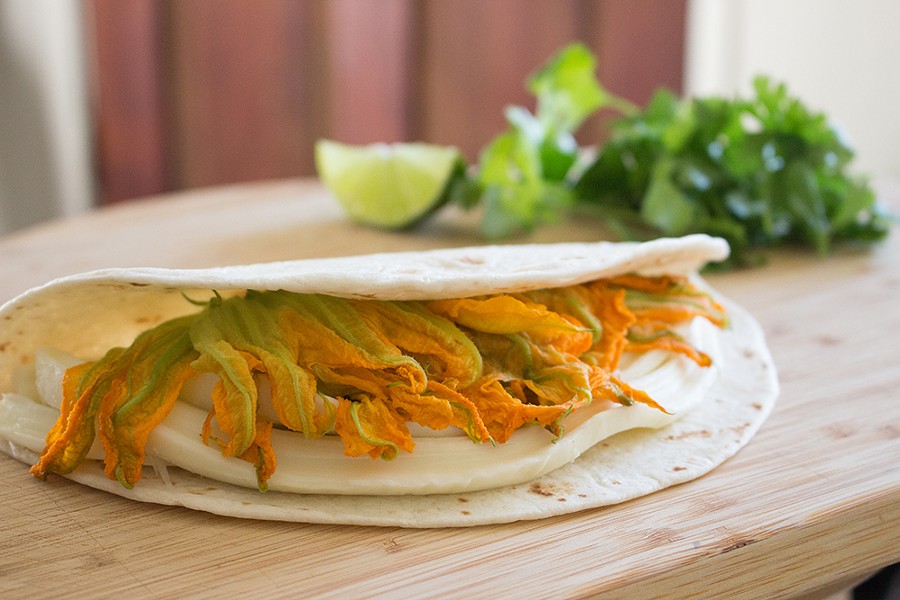Ripe tomatoes, aromatic herbs, and sweet melons. Every late summer, most of us can expect to find our favorites at the farmers' market. But some of the season's treasures are still lesser known: squash blossoms and amaranth greens.
If you love Italian cuisine or are a fan of "trendy" foods, then no doubt you've heard of these uncommon pieces of produce. But make no mistake, neither of these foods is just a trend.
In pre-Hispanic Mexico, these foods were consumed long before Europeans arrived. For a quick history lesson, most of the produce we enjoy is indigenous to the Americas, including squash, chile peppers, corn and beans. Among these fruits and veggies were the wild greens that some of the indigenous people of Mexico called quilitl — literally "wild greens" in the Nahuatl language. Today, the name has changed to quelites but the tradition of foraging for them has remained.
When my mom was growing up in Michoacán, Mexico, with her abuela y tias (grandma and aunts), they would often forage quelites in the mountains. They harvested all sorts of wild greens from verdolagas (purslane) to quintoniles (amaranth greens), as well as flores de calabaza (squash blossoms) and wild purple tomatillos. My mom said that in the rural parts of Mexico like the rancho she grew up in, the wild greens would often grow from the seeds left behind in human and animal waste. Needless to say, these foods have a rich history that is symbiotic with the generations of people who traditionally harvested and consumed them.
During a recent trip to the Arcata Farmers' Market, I was excited to find cempoalxochitl marigold flowers but my heart nearly skipped a beat when I found squash blossoms and amaranth greens. Of course, I gave my mom a call to learn how she would eat them. Although I'm miles away from my mother's ancestral homeland, the food gave me a deeper sense of connection to my heritage. Up here in the north we have some of the world's best produce available throughout the year. This was not always the case and if you're trying to eat seasonally and locally, or simply love Mexican food, you should grab these quelites while they're available. If you've never had the pleasure of eating delicate squash blossoms or a healthy serving of amaranth greens, you're in for a treat.
Flor de Calabaza Quesadilla (Squash Blossom Quesadilla)
This recipe is best kept simple to highlight the flor de calabaza. If you can't find Oaxaca cheese at your local grocery store or Latino market, substitute it with either mozzarella or Monterey jack. Epazote is a native herb of the Americas with a unique taste similar to oregano. Unfortunately, there is no substitute for epazote but you can find the dried variety at most Latino markets. Makes 1 serving but you'll want to make more.
Ingredients:
1 flour tortilla or 2 corn tortillas
4 squash blossoms
¼ cup Oaxaca cheese
1 fresh epazote leaf or 1 teaspoon dried
1 tablespoon oil
¼ medium onion, sliced and caramelized (optional)
Serve with salsa, lime or cilantro.
Method:
Remove the stems and pick the stamen out of the squash blossoms. After pulling the Oaxaca cheese apart, lay it onto the tortilla. Place the squash blossoms on top of the cheese along with the epazote.
Add the oil to a skillet over medium heat. Fold the tortilla and fry, flipping once until the cheese melts. Pair the quesadilla with tomatillo salsa. I found purple tomatillos, a sweeter variety that is often found in the wild, at the farmers' market. If you're feeling ambitious, try adding caramelized onions.
Amaranth Greens and Black Bean Sopes
Another innovative product of corn nixtamalization, sopes serve as a vessel for delicious toppings. Get your hands on prepared masa or the dry mix. You can cook dried beans or use canned. For extra piquancy, add rajas, a topping of peppers cut in strips. Makes 10 servings of sopes.
For the topping:
1 pound amaranth greens
2 cups black beans, cooked
½ medium onion, diced
2 garlic cloves, minced
1 serrano pepper, diced
1 fresh epazote leaf, cut into a chiffonade or 1 teaspoon dried
Salt to taste
Poblano pepper, roasted, peeled and cut into 1-inch strips (optional)
For the sopes:
1½ cup masa harina
1¼ cup warm water
1 teaspoon salt
1 tablespoon corn oil or lard
Serve with queso fresco, salsa, avocado or diced tomatoes.
If using dried masa, combine the masa harina with salt and water until it forms a firm dough. Shape the masa into 10 balls before pressing into thick discs. On a warm griddle, cook about 1 minute, flipping once before removing. Carefully pinch a wall around the warm discs. In a pan over high heat, add oil and fry until crisp on both sides. Stew the beans with garlic, onion, and serrano peppers for at least 10 minutes. Remove the amaranth leaves from a whole bundle. In a covered pot, steam the leaves until wilted. Mix the leaves and epazote into the beans before serving with the optional poblano pepper strips.
Héctor Alejandro Arzate is a Scorpio originally from Richmond, California. When he's not writing, you can find him cooking or working on his jump shot.






Comments